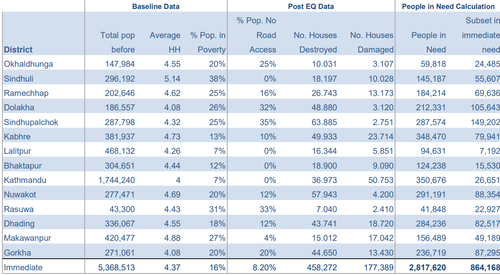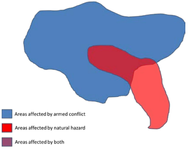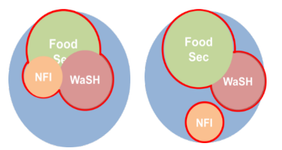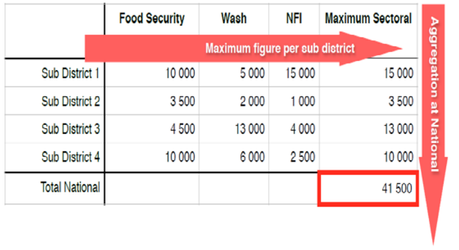Overview
What is People in Need?
The number of people in need of humanitarian assistance helps to define the magnitude of a crisis and the overall cost estimate of an emergency response; it is a prerequisite for strategic planning and response monitoring. Identifying the number of People in Need is also essential to determine priority areas for interventions, when those are defined as a function of people in need, access, and likely deterioration, etc. This section looks at specific examples and step-by-step approaches to derive estimates for the size of the population in need. It assumes that the Total Population, as well as the total number of People Affected (in accordance with the Humanitarian Profile), is known
What does “need” mean?
The term "need" refers to a gap or discrepancy between the status quo and a different desired state. The need is neither the present nor the ideal state; it is the gap between them (ex: damage to the local water system has reduced the availability of safe drinking water by 50%). Need can quantify or qualify the extent of that gap.
Need is a contextually defined concept as it can be influenced by factors such as legal systems, personal values, prior experience, internationally or nationally defined standards. It is also a time-sensitive concept because what is defined as need can often change over time as crisis response progresses.
Because it is an evolving the needs concept needs to be operationally defined for each crisis according to the current context and historical references or benchmarks.
Need is a time sensitive concept
What is defined as a need often changes over time as the fulfillment of basic need permits awareness of a less urgent need. Consequently, unmet needs are often measured differently based on the programming phase – proximity to threat or exposure to death in the first days after a disaster, degree of access to basic services and goods in the following weeks, and so on. As a relative and evolutionary term, the need concept is without widely agreed boundaries. It must be operationally defined for each crisis according to the current context and historical references or benchmarks.
People in Need is a subset that includes:
- whose physical security, basic rights, dignity, living conditions or livelihoods are threatened or have been disrupted, AND
- whose current level of access to basic services, goods, and social protection is inadequate to re-establish normal living conditions with their accustomed means in a timely manner without additional assistance.
How to establish People in Need
The two main approaches to help identify PIN are the top-down and the bottom-up approach.
Top-Down Approach
There are two top-down approaches: 1) The Core Humanitarian Problem approach and 2) The Intensity of Needs approach.
1) The Core Humanitarian Problem Approach
In their simplest form, unmet needs can be measured in relation to a "core humanitarian problem". This approach is based on the premise that there is a common denominator of the population affected and in need, a "core problem" generated by the specific nature of the shock. For example, after a sudden-onset crisis such as an earthquake, food or tropical storm, the core problem and most relevant proxy indicator for people in need can be damage to shelter.
More elaborate constructs for calculating population in need call for the use of composite measures- compounded effects of several dimensions of needs. In conflicts or protracted crisis, several "core humanitarian problems" can derive needs, including status, specific vulnerabilities, loss of livelihoods, limited freedom of movement, lack of access to humanitarian assistance and basic services, specific protection concerns, etc.
A general recommendation to the sectors preparing to join a discussion on an overall number of people in need is to base estimates of the sectoral PIN on the number of people in need of a "full package" of interventions that can help reduce sectoral overlap and follows the "core problem" approach logic.
Strengths
The strength of this approach is it allows clear articulation of a context-specific Affected/People in Need figure and helps the inter-sector prioritization.
Limitations
The limitations of this approach include the acknowledgment that using, for example, shelter as the key indicator is not completely inclusive of all possible groups in need, such as children not in school or people with changed access to health care. However, there is a strong correlation between shelter conditions and other needs, including the potential loss of food or seed stocks, damage of WASH facilities, and exposure to increased protection risks.
Methods for estimating PIN vary significantly according to the country and the type of crisis but also the available data at the moment in the crisis when estimates are needed. This has implications on opportunities and risks for estimating PIN.
When up-to-date, in-crisis information is not available, People in Need can be estimated based on location, pre-crisis vulnerability, and their status.
| Field Example: Ukraine Humanitarian Crisis 2015 | ||
|---|---|---|
The 2015 PIN in Ukraine was calculated using a combination of criteria: location of the affected population, number of people displaced, pre-crisis demographics (age) and vulnerability data (poverty headcount). Of the 5.2 million people living in conflict-affected areas in Ukraine, around 1.4 million were considered to be particularly vulnerable and in need of humanitarian assistance. These 1.4 million people were assumed to be a vulnerable group pre-conflict and disproportionately affected by displacement, loss of income, pensions, eroded purchasing power, reduced access to markets and harsh winter conditions, and are thus considered to be in need of assistance. In this case, unmet needs have not been measured through field assessments and are assumptions. Strengths The strength of this example is its simplicity. A few metrics are used to estimate the total number of PIN and the aggregation method is additive. Another advantage is that is a stand-alone methodology was developed for the Humanitarian Needs Overview (HNO), circumventing the discussion on the sectoral and inter-sectoral overlap. Limitations A limitation of this example is its emphasis on historic vulnerabilities with limited explanatory power for the actual crisis impact. Dynamics specific to the context might remain uncovered, including innovative coping mechanisms, etc. Agreeing on and establishing a baseline to work from is crucial. the lack of such agreement can result in the lack of shared situational awareness and incomparability of the data. another issue is the unavoidable potential for duplication among categories. | ||
| Field Example: Libya Humanitarian Crisis 2015 | |
|---|---|
The Humanitarian Needs Overview 2015 in Libya used mostly the location and the humanitarian profile to identify the number of people in need in the country. 100% of IPDs, refugees and asylum seekers and migrants were considered in need of assistance. However, following a multisectoral assessment, approximately 640,000 residents affected were not considered in need of assistance and were discarded from this category. Furthermore, within the population in need, 1.35 million women and children were identified as vulnerable groups. Strengths The strength of this approach lies in its logical description of the population in need as a subset of the identified groups of the humanitarian profile. | |
2) The Intensity of Needs Approach
Beyond the binary distinction between people in need/not in need, PIN estimates can be further refined or graded using intensity categories. This distinction is particularly used in contexts that are a) protracted and complex; b) experience regular and intense shocks with a very unequal distribution of impact on the population, and c) require prioritization of resources or geographical targeting. This is well established in some cluster practice, for example, the nutrition sector with clearly set thresholds reflecting different and mutually exclusive levels of malnutrition. Working with intensity levels calls for either developing complex composite measures, or using context adapted scales with clear definitions for each gradation, such as the Integrated Phase Classification (IPC) reference table for food security.
Strengths
The strength of this approach resides in the possibility to discriminate between levels of need, making People in Need a more concrete and useful category for targeting and resource allocation.
Limitations
The limitations of this approach lie in the time required to create and agree on comparable intensity levels within and between sectors. In some instances, it might be easier to design only one cross-sector intensity scale (e.g., IPC), distinguishing between the population in moderate and acute need. Another limitation of the approach is the potential for bias when data is lacking.
When up-to-date, in-crisis information is not available, People in Need can be estimated based on location, pre-crisis vulnerability, crisis impact, and their status.
| Field Example: Nepal Humanitarian Crisis 2015 | |
|---|---|
The Assessment Unit in Nepal worked with the census, damage, vulnerability and access data to define the overall PIN. In their approach, they distinguished between people in need, defined as those who require assistance to be able to rebuild their lives, and people in immediate need due to “loss of shelter, lack of access to essential services and poverty”. The methodology used government statistics of fully and partially damaged houses (houses that cannot be repaired vs houses which are repairable) multiplied by the average household size, overlaid with poverty statistics and road access information. For areas without road accessibility, households with fully and partially damaged houses were all considered in need of immediate assistance, regardless of the poverty threshold, as they were expected to face significant logistical challenges to rebuild their houses during the monsoon. For areas where there was road access, fully and partially damaged households were considered in need of immediate assistance if they were below the poverty line in that district. The affected population was considered to have the most limited capacity to recover from earthquake losses due to their pre-existing financial circumstances and their location. People In Need =(Fully damaged households + Partially damaged households) x Average Household Size People in Immediate Need= PIN x ( Population in Poverty% + Population with no Road Access%) Limitations The limitations of this methodology include the assumption of a uniform impact of destruction on people above and below the poverty line. Poverty may be correlated both with lower impact- as low-rise housing less is likely to be destroyed or easier to rebuild- or higher impact, given a lack of resources to rebuild, repair or resupply. For more information please see the Nepal Earthquake: Number of People in Need. | |
Bottom-Up Approach
The bottom-up approach is used where estimates of population in need are already available but an overall PIN figure still needs to be agreed upon. The bottom-up approach consists of several aggregation rules, which if followed, will eliminate overlap and produce a best estimate of the overall, inter-sectoral number of People in Need.
Humanitarian population figures are generally available disaggregated at three levels:
• geographical location (province A, B, and C)
• sector of interest (number of people affected or in need in WASH, food security/food assistance, education, health, etc.)
• the affected group: IDPs, resident population, affected returnees, etc.
Disaggregation by setting (urban/rural), sex and age, socioeconomic status, religion, ethnicity, etc. is less frequent but often required.
Aggregation Rules for the Bottom-Up Approach
Careful attention should be given when aggregating population figures across sectors, geographical area or affected groups. There are several aggregation rules that should be followed to avoid overlap and double counting to produce a best estimate of the overall, inter-sectoral number of People in Need.
Rule #1: Aggregate (Sum) only across mutually exclusive categories or dimensions
The single most important challenge is to avoid double counting when aggregating across multidimensional (i.e. sectors, type of event) and hierarchical (administrative divisions 1, 2 and 3) categories since one particular individual can belong to several categories at the same time. For instance, one individual can be in need in the shelter AND the health sector and will appear in both sectors’ PIN estimates. This calls for specific disambiguation methods when aggregating figures available at geographical and sector level.
| Field Example | |
|---|---|
In the 2015 Humanitarian Needs Overview for Colombia, the population in need was estimated by including people affected by both the armed conflict AND by recurrent natural disasters. The number of people in need due to the armed conflict in 2015 was calculated considering population affected by the armed conflict and armed violence between 2012 and 2014. The number of people in need as a result of natural disasters is an estimate of people living in areas affected both by natural disasters and armed conflict leading to situations of compounded vulnerability. Since the geographical area where both events have happened is the same, using the sum of both populations in need would lead to double counting. | |
Rule #2: When using multidimensional data, use the Max value to avoid double counting
Aggregating PIN across different sectors to obtain an overall figure of people in need is a classic calculation in needs assessment or HNOs. The recommendation is to use the highest sectoral estimate as a proxy for the total of PIN. The highest sectoral estimate will still be lower than the actual number of people in need, considering that individuals will have needs in several sectors. Therefore the highest maximum number will be the smallest common denominator. It is however not possible to simply add up all sectors together because this implies double or multiple counting.
This approach is best used in a context where estimates are available at low administrative levels or affected groups, so aggregation can be performed using as many mutually exclusive categories as possible, even crudely.
| Field Example | |
|---|---|
| For example, if the total population in a given district is 15,000 and there are 15,000 people in need of food assistance, 10,000 in need of WASH and 5,000 in need of NFI, it is obvious that the total number of people in need (15,000+10,000+5,000=30,000) would be greater than the actual population (See figure 13: “actual” number of people with humanitarian needs corresponds to the areas delimited by the red lines.) Given that people with needs in food security may also have needs in WASH and nutrition, an overlap of figures is extremely likely. However, the strength of correlations between needs would have to be known at the individual level in order to count populations with distinct sectoral needs, so it is difficult to ascertain exact figures without a household level representative survey. |
Rule #3: When using the Max value, always use the lowest level of detail in the available hierarchies
| Field Example | |
|---|---|
The Syria Multi-Sectoral Needs Assessment (MSNA) Technical Working Group chose to use the maximum people in need estimates across all sectors, at the lowest administrative level where data was available (subdistrict) and then to sum across all sub-districts to get the total number of PIN. While inter-sector overlap is not known, it is assumed that, derived at a low geographical level, the maximum PIN across sectors is still lower than the actual combined people in need figure. While the combined figure for Sub-District 1 would be 30,000 people in need and would most certainly reflect overlap, the sectoral maximum is 15,000. Therefore the definition of people in need chosen by the Technical Working Group was “people with humanitarian needs in at least one sector”. Strengths The strength of this method lies in the disambiguation effect that it favors: aggregating number of PIN across mutually exclusive categories at the lowest unit of measurement possible, and eliminating the risk of duplication. Limitations The limitations of this approach include its highly conservative mindset and the unknown number of people left over. The method is also not easy to understand without the full dataset and without a technical walkthrough for the audience. For a detailed explanation of the pro and cons of this approach. | |
Rule #4: A sector PIN cannot be higher than the total crisis PIN, OR, avoid using top down and bottom up methodologies for the same crisis
It is important to ensure consistency throughout data, i.e., the number of people in need in one sector cannot be higher than the total number of people in need. Each upper category will be higher than the lower categories, i.e., the number of People in Need cannot exceed the number of People Affected. Remember to prioritize and analyze: not all affected people are in need of humanitarian assistance, and some will be in more urgent need than others.
Rule #5: Document how PIN estimates were produced (dimensions, attributes, definitions, etc.)
Explain your methods no matter how crude or sophisticated. Consumers of the figures need to know and potentially repeat the method and get the same result. In explaining your methods also note the limitations and uncertainties and where figures have been approximated.
Resources
Humanitarian Profile Support Guidance 2016
Nepal Earthquake People in Need 2015








